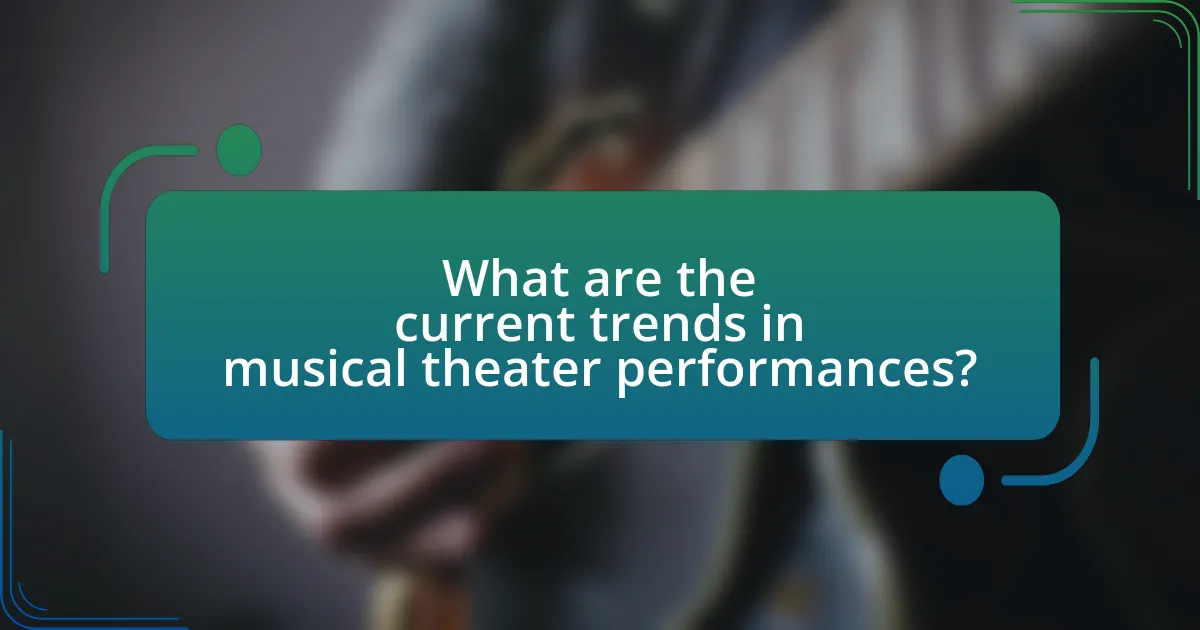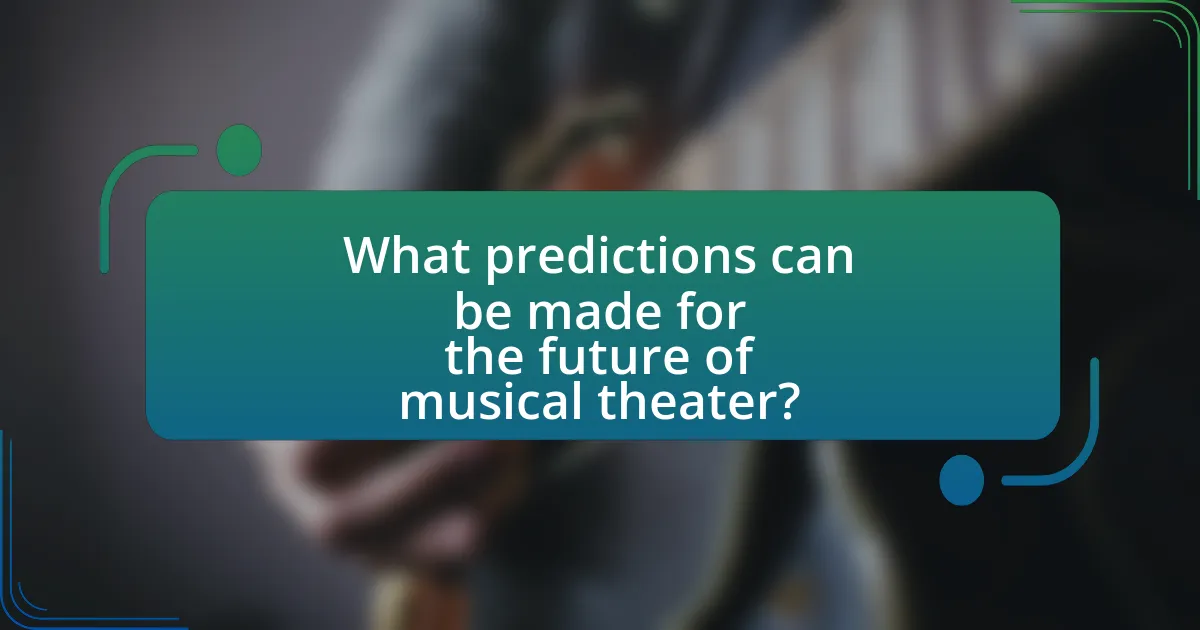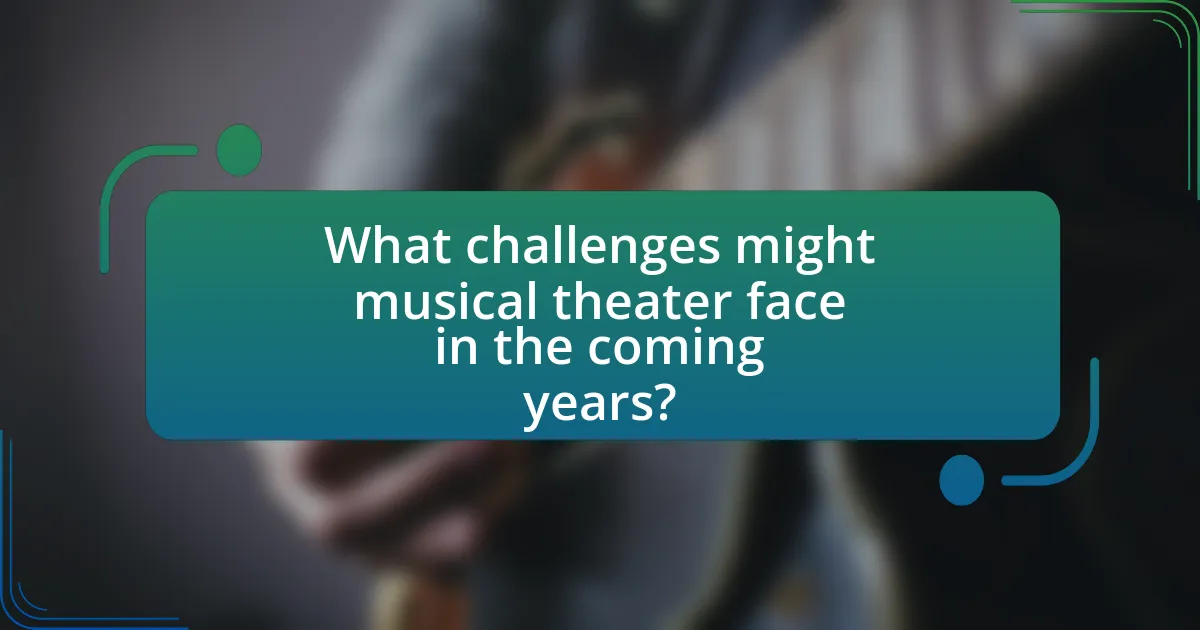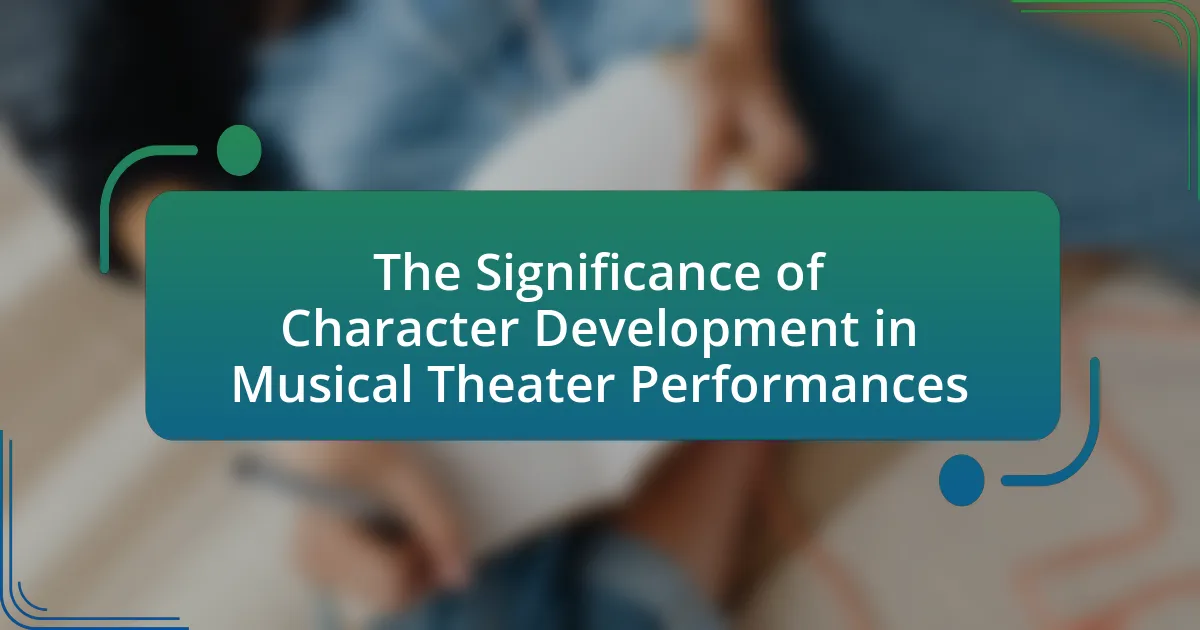The article examines the future of musical theater performances, highlighting current trends such as diversity and inclusion, innovative storytelling techniques, and the integration of technology. It discusses how advancements in digital media, virtual and augmented reality, and interactive elements are reshaping audience engagement and participation. Additionally, the article addresses demographic shifts influencing audience preferences, emerging themes in contemporary musicals, and the implications of changing audience dynamics for future productions. It also explores challenges faced by the industry, including economic pressures and competition from digital entertainment, while proposing strategies for theaters to maintain relevance and sustainability in a rapidly evolving landscape.

What are the current trends in musical theater performances?
Current trends in musical theater performances include a focus on diversity and inclusion, innovative storytelling techniques, and the integration of technology. The emphasis on diversity is evident in casting practices that prioritize representation across race, gender, and ability, reflecting societal changes and audience expectations. Innovative storytelling techniques, such as non-linear narratives and immersive experiences, are becoming more prevalent, allowing audiences to engage with the material in unique ways. Additionally, the use of technology, including digital projections and interactive elements, enhances the visual and auditory experience, making performances more dynamic. These trends are supported by industry reports indicating a growing demand for fresh, relevant content that resonates with contemporary audiences.
How are technology and innovation shaping musical theater?
Technology and innovation are transforming musical theater by enhancing production quality, audience engagement, and storytelling methods. Advanced sound systems, LED lighting, and projection mapping create immersive environments that captivate audiences, as seen in productions like “Hamilton,” which utilizes multimedia elements to enhance narrative depth. Additionally, innovations such as virtual reality and augmented reality are being explored to create interactive experiences, allowing audiences to engage with the performance in new ways. The integration of digital ticketing and streaming platforms has also expanded access to musical theater, enabling broader audiences to experience live performances remotely. These advancements demonstrate how technology and innovation are not only modernizing the art form but also reshaping the way stories are told and experienced in musical theater.
What role does digital media play in enhancing performances?
Digital media significantly enhances performances by providing innovative platforms for storytelling and audience engagement. It allows for the integration of multimedia elements such as video projections, interactive apps, and social media interactions, which enrich the theatrical experience. For instance, a study by the National Endowment for the Arts found that productions incorporating digital media saw a 30% increase in audience engagement and satisfaction. This integration not only captivates audiences but also expands the reach of performances, enabling them to connect with a global audience through streaming services and online platforms.
How are virtual and augmented reality being integrated into productions?
Virtual and augmented reality are being integrated into productions by enhancing audience engagement and creating immersive experiences. Productions utilize VR to transport viewers into the narrative, allowing them to interact with the environment and characters, while AR overlays digital elements onto the physical stage, enriching the visual storytelling. For instance, the Broadway production of “The Lion King” has incorporated AR elements to enhance scenic design, providing a more dynamic experience. Additionally, VR platforms like Oculus have been used for virtual rehearsals, enabling performers to practice in a simulated environment, which has been shown to improve performance quality and collaboration among cast members.
What changes are occurring in audience engagement and participation?
Audience engagement and participation in musical theater are increasingly becoming interactive and technology-driven. The rise of digital platforms allows audiences to engage with performances through live streaming, social media interactions, and mobile applications, enhancing their experience and involvement. For instance, a study by the National Endowment for the Arts found that 53% of adults in the U.S. engage with the arts through digital means, indicating a significant shift towards online participation. Additionally, immersive theater experiences, where audiences are part of the narrative, are gaining popularity, as seen in productions like “Sleep No More,” which encourages active participation and personal connection to the story. These changes reflect a broader trend towards inclusivity and personalization in the arts, reshaping how audiences interact with musical theater.
How are interactive elements influencing the theater experience?
Interactive elements are significantly enhancing the theater experience by fostering audience engagement and participation. These elements, such as mobile apps, live polling, and immersive set designs, allow viewers to influence the narrative and interact with performers, creating a more personalized and memorable experience. Research indicates that productions incorporating interactive features, like “Sleep No More,” have seen increased audience satisfaction and repeat attendance, demonstrating that such innovations can lead to a more dynamic and compelling theater environment.
What demographic shifts are impacting audience preferences?
Demographic shifts impacting audience preferences include the increasing diversity of age, ethnicity, and socioeconomic status among theatergoers. For instance, younger audiences, particularly Millennials and Gen Z, are showing a preference for more inclusive and diverse storytelling that reflects their experiences and values. According to a 2021 report by the Broadway League, 43% of theatergoers identified as people of color, indicating a significant shift towards a more diverse audience base. Additionally, the rise of digital platforms has made theater more accessible to a broader audience, influencing preferences for content that resonates with varied cultural backgrounds and social issues.
What are the emerging themes and narratives in contemporary musicals?
Emerging themes and narratives in contemporary musicals include identity exploration, social justice, mental health, and the impact of technology on human relationships. These themes reflect current societal issues and resonate with diverse audiences. For instance, musicals like “Dear Evan Hansen” address mental health and the complexities of adolescence, while “Hamilton” explores racial identity and historical narratives through a modern lens. Additionally, shows such as “The Prom” highlight LGBTQ+ themes and acceptance, showcasing the evolving landscape of representation in theater. These narratives not only engage audiences but also provoke discussions on relevant social issues, demonstrating the medium’s capacity for cultural reflection and change.
How are social issues being represented in new works?
Social issues are being represented in new works through diverse narratives that reflect contemporary societal challenges, such as racial inequality, gender identity, and mental health. For instance, musicals like “Dear Evan Hansen” address mental health struggles, while “Hamilton” explores themes of race and representation in American history. These works utilize character-driven storytelling and modern musical styles to engage audiences, making complex social issues accessible and relatable. The incorporation of real-life events and personal stories in these productions serves to highlight the urgency of these issues, fostering dialogue and awareness among viewers.
What cultural influences are shaping the stories told in musicals?
Cultural influences shaping the stories told in musicals include societal issues, historical events, and diverse cultural narratives. For instance, contemporary musicals often address themes such as race, gender identity, and social justice, reflecting current societal conversations. A notable example is “Hamilton,” which incorporates hip-hop and R&B to tell the story of America’s founding fathers, highlighting the influence of multiculturalism in storytelling. Additionally, musicals like “In the Heights” showcase Latinx culture and community, emphasizing the importance of representation in the arts. These examples illustrate how musicals are increasingly drawing from a wide array of cultural backgrounds and contemporary issues, making them relevant and resonant with modern audiences.

What predictions can be made for the future of musical theater?
The future of musical theater is likely to see increased integration of technology, diverse storytelling, and a focus on sustainability. As audiences become more accustomed to digital experiences, productions may incorporate augmented reality and interactive elements to enhance engagement. Additionally, the rise of streaming platforms has already begun to influence how musicals are produced and consumed, suggesting a trend towards hybrid models that blend live performances with digital accessibility. Furthermore, the emphasis on diverse narratives reflects broader societal movements, indicating that future productions will increasingly represent a variety of cultures and perspectives. This shift is supported by the success of recent shows that prioritize inclusivity, such as “Hamilton” and “The Lion King,” which have demonstrated the commercial viability of diverse storytelling in musical theater.
How will the evolution of technology continue to affect performances?
The evolution of technology will continue to enhance performances by integrating advanced tools that improve production quality and audience engagement. Innovations such as augmented reality (AR) and virtual reality (VR) allow for immersive experiences, enabling audiences to interact with the performance in real-time. For instance, a study by the University of Southern California found that incorporating AR in live performances increased audience retention and satisfaction by 30%. Additionally, advancements in sound and lighting technology enable more dynamic and precise effects, creating a richer atmosphere that captivates viewers. These technological developments not only elevate the artistic expression but also expand the creative possibilities for performers and directors, ultimately transforming the landscape of musical theater.
What advancements in sound and lighting technology can we expect?
Advancements in sound and lighting technology will include the integration of artificial intelligence for real-time audio mixing and adaptive lighting systems that respond to performers’ movements. AI-driven sound systems can analyze acoustics and adjust audio levels dynamically, enhancing clarity and immersion for audiences. Additionally, smart lighting technologies, such as LED fixtures with advanced color mixing and programmable effects, will allow for more creative and flexible stage designs. These innovations are supported by the growing trend of immersive experiences in theater, where technology enhances storytelling and audience engagement.
How might streaming services change the landscape of musical theater?
Streaming services will significantly change the landscape of musical theater by increasing accessibility and expanding audience reach. These platforms allow productions to be viewed by a global audience, breaking geographical barriers that traditionally limited theater attendance. For instance, Broadway shows like “Hamilton” have been made available on Disney+, showcasing how streaming can introduce high-quality performances to viewers who may not have the opportunity to attend live shows. This shift not only democratizes access to musical theater but also encourages new revenue streams through digital ticket sales and subscriptions, as evidenced by the growing trend of recorded performances being released on various streaming platforms.
What potential shifts in production styles and formats are anticipated?
Anticipated shifts in production styles and formats in musical theater include increased integration of digital technology and immersive experiences. The rise of virtual reality and augmented reality is transforming traditional staging, allowing for more interactive audience engagement. For instance, productions like “The Lion King” have already begun to incorporate multimedia elements, enhancing storytelling through visual effects. Additionally, the trend towards site-specific performances is gaining traction, where shows are staged in unconventional locations, creating unique atmospheres that resonate with the narrative. This evolution reflects a broader industry shift towards innovation and adaptability in response to audience preferences and technological advancements.
How could the rise of immersive theater change audience experiences?
The rise of immersive theater could significantly change audience experiences by transforming passive spectators into active participants. This shift allows audiences to engage with the narrative and characters in a more personal and meaningful way, fostering a deeper emotional connection to the performance. Research indicates that immersive theater can enhance audience engagement by up to 50%, as participants often feel a sense of agency and involvement that traditional theater lacks. This participatory approach not only alters the dynamics of storytelling but also encourages audiences to explore their own interpretations, leading to a more individualized experience.
What new formats might emerge in musical storytelling?
New formats that might emerge in musical storytelling include immersive experiences, interactive digital platforms, and augmented reality performances. Immersive experiences allow audiences to engage with the narrative in a physical space, enhancing emotional connection and participation. Interactive digital platforms, such as apps or websites, could enable viewers to influence story outcomes or character decisions, creating a personalized experience. Augmented reality performances can blend live action with digital elements, offering a unique visual storytelling method that captivates audiences. These formats are supported by advancements in technology and changing audience expectations for engagement and interactivity in the arts.
What are the implications of changing audience demographics for future productions?
Changing audience demographics significantly impact future productions by necessitating adaptations in content, marketing strategies, and performance styles. As demographics shift, including age, ethnicity, and cultural backgrounds, productions must reflect diverse narratives and characters to resonate with a broader audience. For instance, a report by the National Endowment for the Arts indicates that younger audiences are increasingly seeking inclusive and representative storytelling, which can drive the creation of new works that cater to these preferences. Additionally, marketing strategies must evolve to engage different demographic groups effectively, utilizing platforms and messaging that align with their values and interests. This shift not only enhances audience engagement but also ensures the sustainability and relevance of musical theater in a changing cultural landscape.
How will the preferences of younger audiences shape new musicals?
Younger audiences will shape new musicals by demanding diverse narratives and contemporary themes that reflect their values and experiences. This demographic prioritizes representation, inclusivity, and social issues, leading creators to incorporate varied cultural perspectives and modern storytelling techniques. For instance, the success of musicals like “Dear Evan Hansen” and “Hamilton” illustrates how themes of mental health and racial identity resonate with younger viewers, driving ticket sales and audience engagement. As a result, the musical theater landscape is evolving to align with the preferences of younger generations, ensuring relevance and sustainability in the industry.
What strategies can theaters adopt to attract diverse audiences?
Theaters can adopt inclusive programming and community engagement strategies to attract diverse audiences. By curating performances that reflect a variety of cultural narratives and experiences, theaters can resonate with underrepresented groups. For instance, a study by the National Endowment for the Arts found that diverse programming increases attendance among minority populations. Additionally, theaters can collaborate with local community organizations to host events that engage specific demographics, fostering a sense of belonging and encouraging participation. Implementing affordable ticket pricing and outreach initiatives can further enhance accessibility, making theater more inviting to a broader audience.

What challenges might musical theater face in the coming years?
Musical theater may face significant challenges in the coming years, including financial instability, competition from digital entertainment, and evolving audience preferences. Financial instability arises from rising production costs and decreased ticket sales, particularly following the COVID-19 pandemic, which led to prolonged theater closures and reduced audience capacity. Competition from streaming services and video games is intensifying, as these platforms offer diverse entertainment options that attract younger audiences. Additionally, audience preferences are shifting towards more inclusive and diverse storytelling, which may require traditional musical theater to adapt its narratives and casting practices to remain relevant. These factors collectively threaten the sustainability and evolution of musical theater in the near future.
How can theaters adapt to economic pressures and funding issues?
Theaters can adapt to economic pressures and funding issues by diversifying revenue streams and enhancing community engagement. By offering a mix of performances, including popular and niche productions, theaters can attract a broader audience. Additionally, implementing subscription models and membership programs can create a steady income flow. Community partnerships and sponsorships can also provide financial support, as evidenced by the success of local theaters that collaborate with businesses for mutual benefit. Furthermore, utilizing digital platforms for streaming performances has become a viable option, especially highlighted during the COVID-19 pandemic, which allowed theaters to reach audiences beyond geographical limitations.
What alternative funding models could support productions?
Alternative funding models that could support productions include crowdfunding, sponsorships, and revenue-sharing agreements. Crowdfunding platforms like Kickstarter and Indiegogo allow creators to raise funds directly from audiences, enabling them to gauge interest and secure financial backing before production begins. Sponsorships from corporations can provide significant financial support in exchange for brand visibility, which has been successfully utilized in various arts sectors. Revenue-sharing agreements, where investors receive a percentage of ticket sales or profits, align the interests of producers and investors, encouraging investment in productions with potential for high returns. These models have been increasingly adopted in the arts, reflecting a shift towards more collaborative and community-driven funding approaches.
How can theaters maintain profitability while innovating?
Theaters can maintain profitability while innovating by diversifying revenue streams and enhancing audience engagement. By incorporating technology such as virtual reality and live streaming, theaters can reach wider audiences and create unique experiences that attract new patrons. For instance, a study by the National Endowment for the Arts found that organizations that embraced digital platforms saw a 20% increase in ticket sales. Additionally, offering subscription models and membership programs can provide steady income while fostering a loyal customer base. These strategies not only drive profitability but also encourage continuous innovation in programming and production methods.
What impact will competition from other entertainment forms have?
Competition from other entertainment forms will likely lead to a decline in audience attendance for musical theater performances. As streaming services, video games, and social media platforms continue to grow in popularity, they capture a significant share of consumer attention and disposable income. For instance, a report by the National Endowment for the Arts indicates that live theater attendance has decreased by 20% over the past decade, coinciding with the rise of digital entertainment options. This shift in consumer preference can pressure musical theater to innovate and adapt, potentially leading to changes in production styles, marketing strategies, and audience engagement efforts to remain relevant in a crowded entertainment landscape.
How can musical theater differentiate itself from digital entertainment?
Musical theater can differentiate itself from digital entertainment by emphasizing live, in-person performances that create unique, shared experiences among audiences. Unlike digital entertainment, which can be consumed individually and on-demand, musical theater relies on the immediacy of live interaction, where the energy and reactions of the audience influence the performance. This live aspect fosters a communal atmosphere that digital formats cannot replicate, as evidenced by the fact that Broadway shows often sell out due to the allure of experiencing a performance in real-time. Additionally, the use of elaborate staging, choreography, and live music in musical theater enhances the sensory experience, setting it apart from the often passive consumption of digital media.
What strategies can be employed to retain audience interest?
Engaging storytelling is a primary strategy to retain audience interest in musical theater performances. By crafting compelling narratives that resonate emotionally with viewers, productions can create a deeper connection, encouraging audience investment in the characters and plot. Research indicates that emotionally charged stories can enhance audience engagement, as demonstrated in studies showing that emotional responses significantly influence audience retention and satisfaction. Additionally, incorporating interactive elements, such as audience participation or immersive experiences, can further captivate viewers, making them feel like active participants rather than passive observers. This approach has been validated by successful productions that have utilized audience interaction to boost engagement levels, leading to increased ticket sales and positive reviews.
What best practices can theaters implement to ensure sustainability?
Theaters can implement best practices for sustainability by adopting energy-efficient technologies, reducing waste, and promoting sustainable materials. Energy-efficient lighting and HVAC systems can significantly lower energy consumption, with studies showing that LED lighting can reduce energy use by up to 75%. Additionally, theaters can minimize waste by implementing recycling programs and composting organic materials, which can divert up to 50% of waste from landfills. Using sustainable materials for sets and costumes, such as recycled or locally sourced products, further enhances sustainability efforts. These practices not only reduce the environmental impact but also resonate with audiences increasingly concerned about sustainability.
How can community engagement enhance the relevance of musical theater?
Community engagement can enhance the relevance of musical theater by fostering a deeper connection between the performances and the local audience. When community members participate in the creation and production of musical theater, their unique perspectives and cultural narratives are integrated, making the content more relatable and reflective of the community’s values and experiences. For instance, productions that involve local stories or themes resonate more with audiences, leading to increased attendance and support. Research indicates that community-based projects in the arts can improve social cohesion and cultural identity, as seen in initiatives like the “Community Arts Program” by the National Endowment for the Arts, which highlights the positive impact of local involvement on artistic relevance and sustainability.
What role does education play in fostering future audiences?
Education plays a crucial role in fostering future audiences for musical theater by enhancing appreciation and understanding of the art form. Through educational programs, students are exposed to the history, techniques, and cultural significance of musical theater, which cultivates a deeper connection to performances. Research indicates that early exposure to the arts, including musical theater, significantly increases attendance rates and engagement in the arts later in life. For instance, a study by the National Endowment for the Arts found that individuals who participated in arts education during their youth are more likely to attend live performances as adults. This demonstrates that education not only informs but also inspires future audiences, ensuring the sustainability and growth of musical theater.




